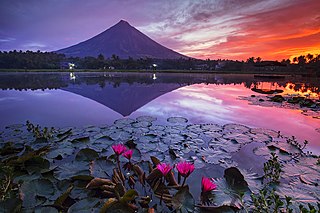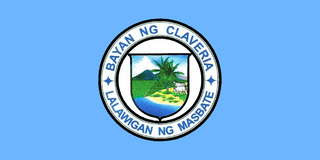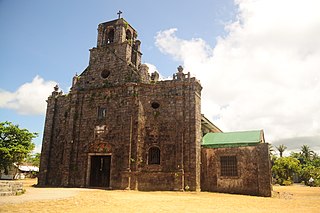
Albay, officially the Province of Albay, is a province in the Bicol Region of the Philippines, mostly on the southeastern part of the island of Luzon. Its capital is the city of Legazpi, the regional center of the whole Bicol Region, which is located in the southern foothill of Mayon Volcano.

Sorsogon, officially the Province of Sorsogon, is a province in the Philippines located in the Bicol Region. It is the southernmost province in the island of Luzon and is subdivided into fourteen municipalities (towns) and one city. Its capital is Sorsogon City and borders the province of Albay to the north.

Masbate, officially the Province of Masbate, is an island province in the Philippines located near the midsection of the nation's archipelago. Its provincial capital is Masbate City, the most populous in the province. The province consists of three major islands: Masbate, Ticao and Burias.

The Bicol Region, designated as Region V, is an administrative region of the Philippines. It comprises six provinces, four on the Bicol Peninsula : Albay, Camarines Norte, Camarines Sur, and Sorsogon, and two off the shore: Catanduanes and Masbate.

Camarines Norte, officially the Province of Camarines Norte, is a province in the Philippines located in the Bicol Region in Luzon. Its capital is Daet, the most populous town in the province. The province borders Quezon to the west, Camarines Sur to the south, and the Philippine Sea to the north. It has historically been a Bikol-speaking region. However, there has been a language shift in recent years to Tagalog, which is more commonly used nowadays.

Sorsogon City, officially the City of Sorsogon, is a 2nd class component city and capital of the province of Sorsogon, Philippines. According to the 2020 census, it has a population of 182,237 people. Sorsogon City is the most populous city in the province, third most populous city in the entire Bicol Region and one of the leading cities in urbanization and most promising city in terms of development.

Masbate City, officially the City of Masbate, is a 4th class component city and capital of the province of Masbate, Philippines. According to the 2020 census, it has a population of 104,522 people.

Claveria, officially the Municipality of Claveria, is a 3rd class municipality in the province of Masbate, Philippines. According to the 2020 census, it has a population of 42,142 people. Ranked 592nd among 1,488 municipalities in the Philippines.

Barcelona, officially the Municipality of Barcelona, is a 5th class municipality in the province of Sorsogon, Philippines. According to the 2020 census, it has a population of 20,987 people.

Gubat, officially the Municipality of Gubat, is a 1st class municipality in the province of Sorsogon, Philippines. According to the 2020 census, it has a population of 60,294 people.

The Metropolitan Archdiocese of Cáceres is a Latin Church archdiocese of the Catholic Church in the Philippines. It is a metropolitan see that comprises the Bicol Region, while directly overseeing the third, fourth, and fifth congressional districts of Camarines Sur, Naga City, Iriga City and the Municipality of Gainza. The archdiocese, having been founded in 1595 in Nueva Cáceres, is also considered one of the oldest dioceses in the Philippines with Cebu, Segovia and Manila, and once had jurisdiction that stretched from Samar in the south and Isabela Province in the north. The seat of the archdiocese is currently located in Naga City, also known as the Queen City of Bicol.

The Bicolano people are the fourth-largest Filipino ethnolinguistic group. Their native region is commonly referred to as Bicolandia, which comprises the entirety of the Bicol Peninsula and neighboring minor islands, all in the southeast portion of Luzon. Males from the region are often referred to as Bicolano, while Bicolana may be used to refer to females.

Potenciano Gregorio, often referred to as Potenciano Gregorio Sr. was a Bicolano musician. He was the composer of "Sarung Banggi", a waltz that is the most famous song in the Bikol language.

Central Bikol, commonly called Bikol Naga or simply as Bikol, is an Austronesian language spoken by the Bicolanos, primarily in the Bicol Region of southern Luzon, Philippines. It is spoken in the northern and western part of Camarines Sur, second congressional district of Camarines Norte, eastern part of Albay, northeastern part of Sorsogon, San Pascual town in Masbate, and southwestern part of Catanduanes. Central Bikol speakers can be found in all provinces of Bicol and it is a majority language in Camarines Sur. The standard sprachraum form is based on the Canaman dialect.

Wenceslao "Bintao" Quinito Vinzons Sr. was a Filipino patriot and leader of the Philippine armed resistance against the Japanese invasion in World War II. He was the youngest delegate to the 1935 Philippine Constitutional Convention. For leading demonstrations as a student leader, he was dubbed the "Father of Student Activism in the Philippines" when he, along with Narciso J. Alegre and future Senator and Vice-President Arturo M. Tolentino, founded the Young Philippines Party.

Ako Bicol Political Party (AKB) is a political party in the Philippines participating in the party-list elections in the Philippines. It represents the Bicol Region and the Bicolano people. In the 2016 elections, AKB was the top partylist with 1,664,975 votes, earning it 3 seats in Congress.

Ibalon, or Ibalong, is the ancient name of the Bicol Region in the Philippines. The center of settlement is believed to be either beside the Bicol River at present-day Libmanan, Camarines Sur or in Magallanes, Sorsogon, Philippines, renowned as one of the first Spanish settlements in the island of Luzon. At some point, the name Ibalong was also used by the Spanish to refer to the entire Bicol Peninsula and, to some extent the entire island of Luzon.

The Bikol languages or Bicolano languages are a group of Central Philippine languages spoken mostly in the Bicol Peninsula in the southeastern part of Luzon, the neighboring island-province of Catanduanes, and the island of Burias in Masbate.
Bisakol is an informal term for the three Bisayan languages spoken in the Bicol Region.

Juan Bautista Alegre y Levantino was a Filipino statesman, a delegate of the first Philippine Independence Mission of 1919 to Washington, D.C., Secretary of the National Committee of the Philippine Independence Commission of 1922, a member of the first Philippine Independence Congress of 1930, and Senator of the Philippines.




















